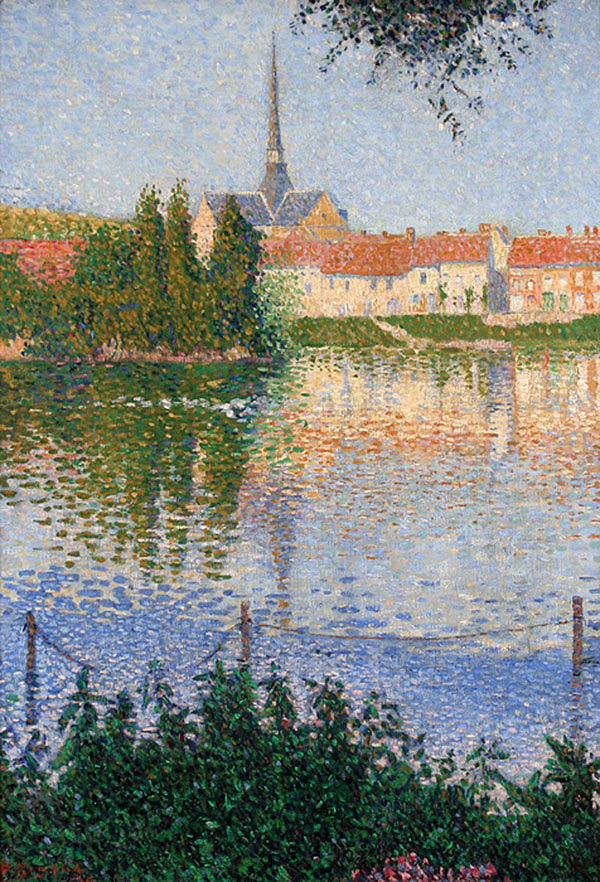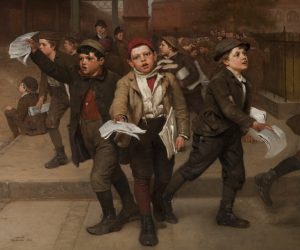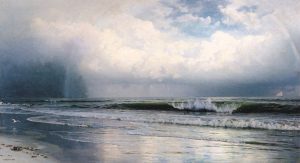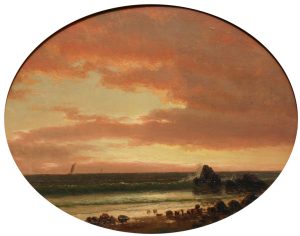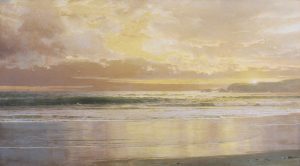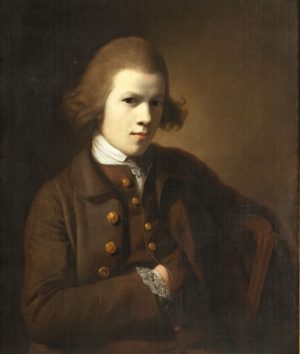Paul Signac (1863-1935)
Signac was born in Paris on November 11, 1863. From a very young age, he decided to become a painter. He made his début in the last Impressionist Exhibition and his work from that time shows distinctly the influence of Monet. He studied with Blin in 1883, and the following year was one of the founding-exhibitors at the first Salon des Indépendants, through which he met Seurat.
In the mid 1880s Signac and Seurat became close friends and the two collaborated in studying theories of painting and color, in particular the division of light in its prismatic elements. In his own work, Signac took to Pointillism, juxtaposing tiny points of color on the canvas in very precise relationships, so that the luminosity and depth of the composition is intensified, and each brush stroke acts to stimulate the eye’s perception of the overall effect. It was a highly scientific approach to painting in which the analytical study of color and the controlled application of pigment became key factors. Based on these methods, he and Seurat developed the theories of Neo-Impressionism, which was explored in depth in Signac’s book From Eugène Delacroix to Neo-Impressionism (1889). Signac rallied a group of artists that included Pissarro and many others to the cause of Neo-Impressionism and spent a great deal of time and energy in promoting it.
At about the turn of the century, Signac’s work witnessed a decisive shift from the precise pointillist technique to a more fluid, less systematic brushstroke to create small rectangles. The bold tones and his use of broader, mosaic-like patches of color are typical of his mature style. Bold, expressive brushstrokes that enliven the surface of a picture are typical of the artist’s later work.
In From Eugène Delacroix to Neo-Impressionism, Signac himself describes his process of color composition in terms of contrasts: ‘the painter, starting from the contrast of two opposing colors, modifies and balances them across the spectrum until he meets another contrast and starts the process over again. So, working from contrast to contrast, he covers the canvas.’
In addition to his many other activities, Signac was a skilled and ardent sailor. Sailing along the coast from Brittany to Provence, he was one of the first artists to discover St. Tropez, which served as home base for his voyages to Holland, Corsica, and various forts along the Mediterranean and Atlantic coasts.
From these trips he often brought back bright, spontaneous watercolors in which he can explore the relationship between a port and its reflection in the water. His application of watercolor in short horizontal, vertical and diagonal strokes not only imitates the rippling water, but the intermingling colors fuse together to project a luminescent effect of dappled sunlight rippling through the waters.
He was elected President of the Société des Artistes Indépendants in 1908 and he held the post for twenty-six years, during which he worked energetically to promote art and encourage artists. He died in Paris in 1935. He is represented in the principal museums of modern art throughout the world.
Les Andelys, L’île à Lucas 1886
by Paul Signac (1863-1935)
| Medium | Oil |
| Medium Detail | Oil on canvas |
| Dimensions | 26 x 17 3/8 inches |
| Signed Location | Signed and dated P. Signac 86, lower left |
| Date Created | 1886 |
| Provenance | Gift from Signac to the writer Charles Toquet (a childhood friend of the artist) Gaston Levy, Paris Wildenstein & Co., Ltd., London Sir Keith Murdoch, Melbourne (1939) Sale, Joel's, Melbourne, 11-13 March 1953, lot 244 (sold for 820 GNS) Herbert Shaw, Melbourne (purchased at the above sale) E. M. Yale, Melbourne (by descent from the above) Sale, Christie's, London, 21 March 1983, lot 14 Private Collection (purchased at the above sale) |
| Literature | Félix Fénéon, Les Impressionistes en 1886..., Paris, 1886, pp. 39-40 P. Adam, “Les Artists Indépendants,” Le Vogue, 6-13 September, 1886, p. 263 E. Hennequin, “Choses d'art, L'Exposition des artists indépendants,” La Vie moderne, Paris, 11 September 1886, pp. 581- 582 Félix Fénéon, L'Art Moderne, Paris, 19 September 1886 “Modern Art Exhibition Ready for Opening,” The Advertiser, Adelaide, 19 August 1939, shown in a publicity photograph of the opening exhibition (next to Seurat's Study for 'Les Chahuts'), after p. 23. Françoise Cachin, Signac, Catalogue Raisonné de l'Oeuvre Peint, Paris, 2000, no. 119, p. 174, illustrated. Eileen Chanin and Steven Miller, Degenerates and Perverts: The 1939 Herald Exhibition of French and British Contemporary Art, Melbourne, 2005, p. 18, shown in a photograph of the opening of the exhibition in Adelaide; p. 164, illustrated; p. 268, in the catalogue of the exhibition. |
| Comments | Signac considered his Andelys pictures his breakthrough and thus gave them all to close friends, including one to Camille Pissarro and another to the art critic Félix Feneon (literature reference by him in the above tear sheet). Signac gave the present work to his friend Charles Toquet. Toquet eventually sold this picture to Gaston Levy, a prominent French collector who became Signac’s greatest benefactor eventually owning about 200 works by the artist. Levy was a very successful man, founding the Monoprix supermarket chain in France, and amassed a legendary collection, which went up for auction on 17 November 1932 (“The G.L. Sale”). It is believed that this picture was sold at that time to Wildenstein, who, as was their custom, had it relined. The picture sold in 1939 to Keith Murdoch, Rupert Murdoch’s father. Murdoch lent it to the very famous 1939 Herald Exhibition of French and British Contemporary Art which traveled throughout the country. Easily the most important art exhibition in the history of Australia, the Herald Exhibition introduced pictures by many of the Impressionist and Modern artists and kept them in Australia through the war. As momentous as this show was, it divided the community, and caused some critics, including J. S. MacDonald, director of the National Gallery of Victoria, to label the artists “degenerates and perverts.” The work then stayed in Australian collections until it was finally sold to the current owner, an American. Les Andelys L'île à Lucas was painted was painted from June to July in the summer of 1886, a pivotal year not only in Signac’s art, but also in the development of the Neo-Impressionist movement. By the early months of 1886 Georges Seurat finished his now celebrated painting Une dimanche apres-midi a l’ille de la Grande Jatte, which caused a sensation when exhibited at the Eighth (and final) Impressionist Exhibition in May 1886. It was also in 1886 that Signac painted his first Divisionist (or Pointillist) compositions, and that the term “Neo Impressionism” was first published in an article written by the art critic (and friend of Signac’s) Felix Feneon. It was this revolutionary chain of events that set the stage for Signac’s works executed during the summer of 1886. In June of that year Signac went to Les Andelys, a village on the river Seine near Rouen, some hundred kilometers from Paris, characterized by steep white chalk cliffs partially covered in vegetation. He was later joined by Lucien Pissarro, and the two artists spent the summer there painting the local scenery. Paul Signac executed ten oil paintings of Les Andelys, two of which, including the present work, were shown in the 1886 Salon des Artistes Independants; while four others were shown at the 1887 exhibition. Three of the ten works from this group now belong to major international museums. (The Art Institute of Chicago and the Musee d’Orsay in Paris are two of those museums). Signac was involved in establishing the first Salon in 1884, and from then on exhibited there annually. It was while organizing the first Salon that he met Georges Seurat, Charles Angrand and Henri Cross, all of whom were to become key figures in the Neo-Impressionist movement. When exhibited at the 1886 and 1887 Salons, Signac’s views of Les Andelys, including the present work, received wide critical acclaim. They were praised for their extraordinary luminosity, and the complexity of composition the artist was able to achieve using small dabs of paint. The critic Paul Adam wrote that the dots in Signac’s paintings had become more refined and varied. Among Paul Signac’s paintings of the 1880s, the ones executed at Les Andelys are among his brightest and boldest in his treatment of color, inspired by the rich and varied coloration of the local scenery. Their characteristic combination of blue, green and orange tones renders these works even brighter and more luminous than Signac’s depictions of the Mediterranean coast executed during his first trip to Collioure in 1887. |
This artwork is no longer in our inventory
Contact Us About This Piece

